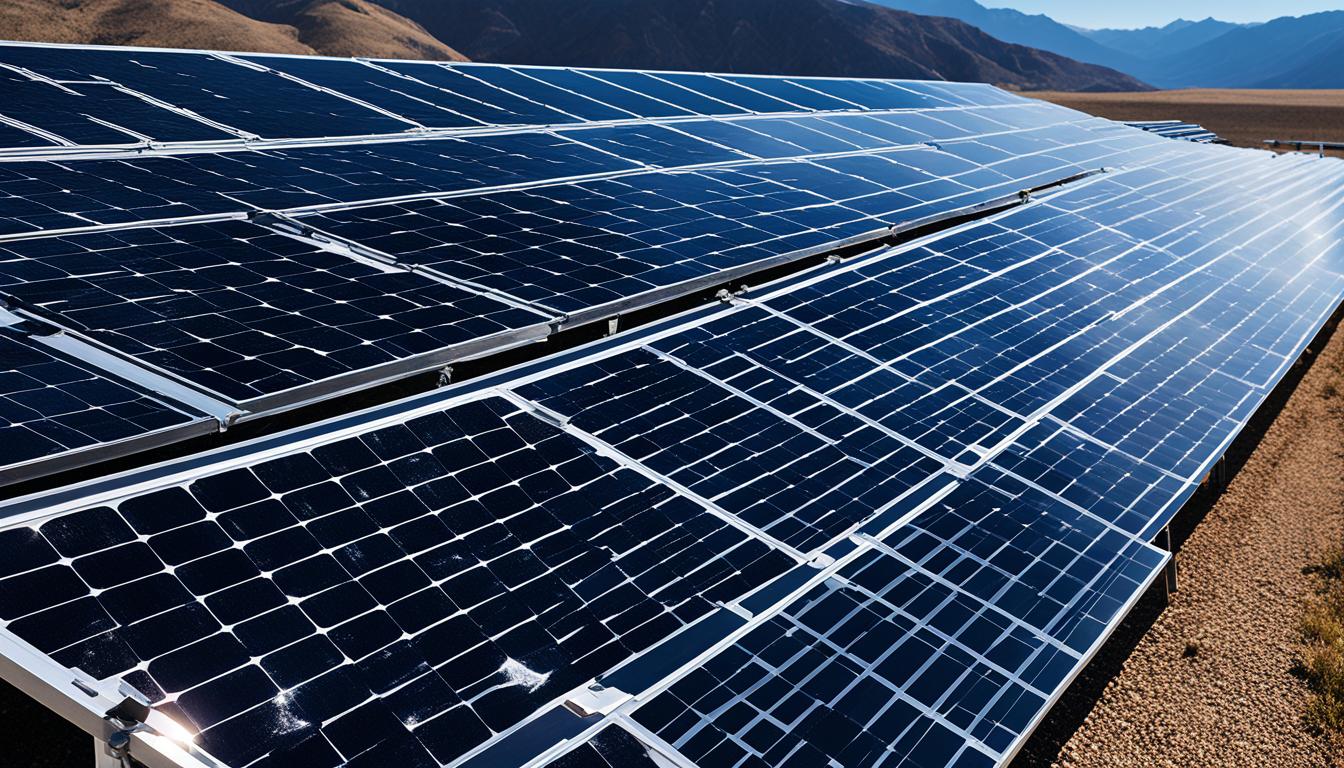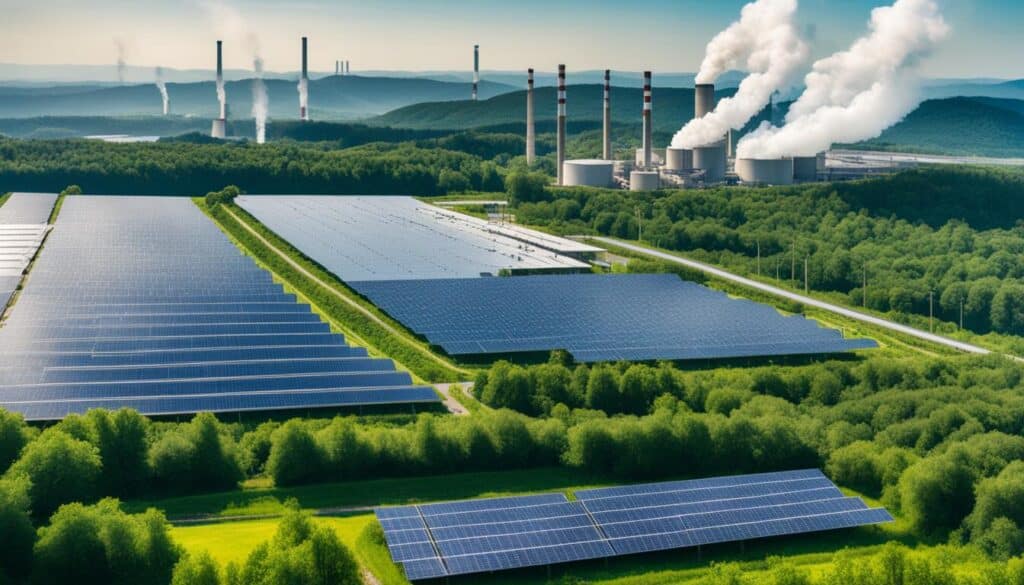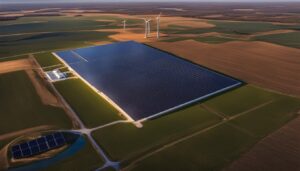
A solar photovoltaic power plant is an advanced facility that harnesses the energy of the sun to generate electricity. It utilizes solar panels made up of photovoltaic cells to convert sunlight directly into electricity. These power plants play a crucial role in the generation of clean and sustainable energy in the United States. With the increasing focus on reducing greenhouse gas emissions and transitioning to renewable energy sources, solar photovoltaic power plants have become a key component of the energy landscape.
Key Takeaways:
- Solar photovoltaic power plants use solar panels and photovoltaic cells to convert sunlight into electricity.
- They contribute to clean energy generation and help reduce carbon emissions.
- These power plants play an important role in achieving energy independence and promoting a sustainable future.
- Technological advancements and increasing demand for clean energy drive the future growth of solar photovoltaic power plants.
- The solar energy market is experiencing steady growth, with a focus on increased efficiency and cost reduction.
The Working Principles of a Solar Photovoltaic Power Plant
A solar photovoltaic power plant operates based on the fundamental principles of solar panels and photovoltaic cells. These power plants harness the abundant energy from the sun and convert it into usable electricity, making them an essential part of the clean energy generation landscape.
Solar panels are the building blocks of a solar photovoltaic power plant. These panels, often arranged in large arrays, are strategically positioned to capture sunlight effectively. They consist of photovoltaic cells, which are responsible for the conversion process.
Photovoltaic cells are made up of semiconductor materials, commonly silicon, that have unique properties. When sunlight hits the surface of the solar panels, it excites the electrons in the photovoltaic cells, causing them to move and flow. This phenomenon is known as the photovoltaic effect.
The movement of these electrons generates a direct current (DC) electricity within the photovoltaic cells. This electricity is then captured and harnessed for various applications, including grid connection for supplying electricity to homes, businesses, and communities.
Intriguingly, the process where photon particles from sunlight energize the electrons in the photovoltaic cells to produce electrical energy demonstrates the marvel and versatility of solar photovoltaic power plants. It showcases how solar panels, included in vast arrays, and composed of photovoltaic cells enable the conversion of sunlight into electricity, ultimately contributing to sustainable electricity generation.
| Advantages of Solar Photovoltaic Power Plants |
|---|
| 1. Clean and Renewable Energy Source |
| 2. Reduced Carbon Emissions |
| 3. Energy Independence |
The table above outlines some of the advantages of solar photovoltaic power plants. They help in the realization of clean energy goals, significantly reduce carbon emissions, and promote energy independence by decreasing reliance on traditional fossil fuels for electricity generation.
As illustrated in the image above, solar panels play a crucial role in capturing sunlight and converting it into electricity through the photovoltaic effect. The installation of solar panels in large arrays enables efficient electricity generation from solar energy.
Benefits of Solar Photovoltaic Power Plants
Solar photovoltaic power plants offer numerous benefits for individuals, communities, and the environment. By harnessing solar energy, these power plants contribute to the generation of clean and renewable energy, reducing the reliance on fossil fuels and decreasing carbon emissions. They play a vital role in combating climate change and promoting a sustainable future.
1. Clean and Renewable Energy
Solar photovoltaic power plants generate electricity using sunlight, which is an abundant and infinitely renewable resource. By tapping into this clean energy source, these power plants contribute to a greener, more sustainable energy mix.
2. Reduced Carbon Emissions
Traditional energy generation methods, such as burning fossil fuels, produce significant amounts of carbon dioxide and other greenhouse gases. Solar photovoltaic power plants, on the other hand, produce electricity without any direct emissions. This helps to reduce carbon emissions and mitigate the impact of climate change.
3. Energy Independence
Solar photovoltaic power plants provide an opportunity for individuals and communities to become more energy independent. By generating their own electricity, they are less reliant on the grid and are better prepared to withstand power outages or disruptions. This energy independence also empowers individuals to take control of their energy consumption and reduce their reliance on conventional energy sources.
4. Cost Savings
Investing in solar photovoltaic power plants can result in long-term cost savings. While the initial installation costs may be higher compared to conventional energy sources, solar power has minimal operational and maintenance expenses. Moreover, many governments and utility companies offer incentives, such as tax credits and net metering, which can further reduce the upfront costs and provide ongoing financial benefits.
“Solar photovoltaic power plants play a significant role in the transition towards a cleaner and more sustainable energy future. By harnessing the power of the sun, we can reduce our reliance on fossil fuels, cut carbon emissions, and work towards a more resilient and independent energy system.”
– Dr. Kimberly Thompson, Renewable Energy Expert
To illustrate the impact of solar photovoltaic power plants on clean energy generation and reduced carbon emissions, consider the following table:
| Benefit | Description |
|---|---|
| Clean Energy Generation | By harnessing solar energy, solar photovoltaic power plants contribute to the generation of clean and renewable electricity. |
| Reduced Carbon Emissions | Compared to fossil fuel-based power plants, solar photovoltaic power plants produce electricity without direct emissions, helping to reduce carbon emissions and combat climate change. |
| Energy Independence | Solar photovoltaic power plants enable individuals and communities to generate their own electricity, reducing reliance on the grid and promoting energy independence. |
By leveraging the benefits offered by solar photovoltaic power plants, we can move closer to a future characterized by clean energy, reduced carbon emissions, and enhanced energy independence.

The Future of Solar Photovoltaic Power Plants
The future of solar photovoltaic power plants looks promising, driven by ongoing technological advancements and a growing demand for clean energy. As the world shifts towards a more sustainable and environmentally friendly energy landscape, solar energy is expected to play a key role in meeting the rising global energy needs.
One of the main drivers of the future growth of solar photovoltaic power plants is the continuous improvements in technology. Researchers and scientists are constantly pushing the boundaries of solar panel efficiency, making substantial progress in increasing the conversion rate of sunlight into electricity. These technological advancements have resulted in greater power output, enabling solar power plants to generate more electricity from the same amount of sunlight.
Moreover, the cost of solar panel installations has significantly reduced over the years, making solar photovoltaic power plants more economically viable. With economies of scale, the production and installation costs of solar panels have decreased, making clean energy generation more accessible and affordable for both residential and commercial consumers. This cost reduction has further fueled the growth of the solar energy market, attracting more investors and driving innovation in the sector.
With increased efficiency and cost reduction, solar photovoltaic power plants are poised to become an integral part of the global energy mix. They offer a sustainable and reliable solution for meeting the ever-increasing demand for electricity while reducing dependence on fossil fuels and mitigating the effects of climate change. As the solar energy market continues to expand, we can expect to witness further advancements and innovations that will shape the future of clean energy generation.
FAQ
What is a solar photovoltaic power plant?
A solar photovoltaic power plant is an advanced facility that harnesses the energy of the sun to generate electricity. It utilizes solar panels made up of photovoltaic cells to convert sunlight directly into electricity.
How do solar photovoltaic power plants work?
Solar photovoltaic power plants consist of solar panels that are installed in large arrays to capture sunlight. These panels are made up of photovoltaic cells, which are responsible for converting sunlight into electricity through the photovoltaic effect.
What are the benefits of solar photovoltaic power plants?
Solar photovoltaic power plants offer numerous benefits for individuals, communities, and the environment. By harnessing solar energy, these power plants contribute to the generation of clean and renewable energy, reducing the reliance on fossil fuels and decreasing carbon emissions.
What is the future of solar photovoltaic power plants?
The future of solar photovoltaic power plants looks promising, driven by ongoing technological advancements and a growing demand for clean energy. The solar energy market is experiencing steady growth, with increasing adoption and investment in solar power infrastructure.








